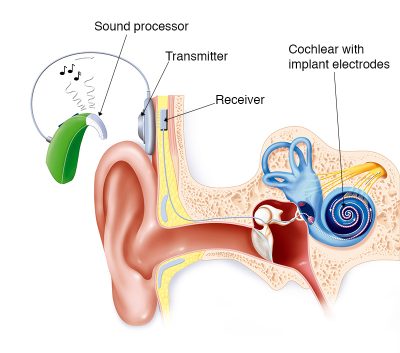 Cochlear implants are surgically-implanted electronic devices that can provide sound for people who receive little or no benefit from hearing aids. Hearing aids make sounds more audible by increasing the level of sound that enters the ear. For some adults and children, however, just increasing the sound level may not be enough to enable hearing because the mechanisms in the inner ear (cochlea) that convert sound into the electrical signals used by the brain are not functionally normally. This can happen at birth (congenital causes) or can happen in childhood or adulthood because of the results of some diseases (such as meningitis or measles), noise exposure, or the side effects of life-saving pharmaceuticals. In such cases, a cochlear implant may be more successful than hearing aids because they bypass the damaged cochlea and directly stimulates the nerve of hearing – the cochlear nerve. An external speech processor converts sound picked up by a microphone into electrical signals and the processed signals are transmitted across the skull as radio waves. The signals are then sent by a surgically-implanted receiver to the tiny electrodes that have been inserted into the cochlea. The electrodes are very close to the nerve of hearing and enable different regions of the nerve to be stimulated when different sounds are picked up by the external microphone.
Cochlear implants are surgically-implanted electronic devices that can provide sound for people who receive little or no benefit from hearing aids. Hearing aids make sounds more audible by increasing the level of sound that enters the ear. For some adults and children, however, just increasing the sound level may not be enough to enable hearing because the mechanisms in the inner ear (cochlea) that convert sound into the electrical signals used by the brain are not functionally normally. This can happen at birth (congenital causes) or can happen in childhood or adulthood because of the results of some diseases (such as meningitis or measles), noise exposure, or the side effects of life-saving pharmaceuticals. In such cases, a cochlear implant may be more successful than hearing aids because they bypass the damaged cochlea and directly stimulates the nerve of hearing – the cochlear nerve. An external speech processor converts sound picked up by a microphone into electrical signals and the processed signals are transmitted across the skull as radio waves. The signals are then sent by a surgically-implanted receiver to the tiny electrodes that have been inserted into the cochlea. The electrodes are very close to the nerve of hearing and enable different regions of the nerve to be stimulated when different sounds are picked up by the external microphone.
The results achieved by cochlear implants are quite spectacular given that the electrode array provides only a small fraction of the full capability of the cochlear nerve to carry detailed information about sounds. Although the implants often enable patients to converse without lipreading, and many are able to converse using a telephone, there is huge variability in benefit listeners gain using a cochlear implant. Even those gaining the most benefit would like to enjoy music more or find it easier to understand speech in a background of voices, such as in a crowded restaurant. This indicates that there is plenty of scope for improving cochlear implant technology. Research from our lab and from centres from around the world is centred on making these improvements.
Cochlear implants are available from four manufacturers in the US.